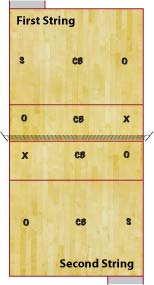Volleyball: The benefits of the ‘Baseball Drill’
Shane Davis, the head volleyball coach at Northwestern University, loves gleaning information from other sports to use in his program. He attends basketball practices to learn from that game, and he has installed a “Baseball Drill” into his volleyball practices.
The ‘Baseball Drill’
 DIAGRAM: Put the first string on one side of the net, and the second string on the other (in the diagram, S is for setter, O is for outside hitter, X is for opposite hitter and CB is for center blocker).
DIAGRAM: Put the first string on one side of the net, and the second string on the other (in the diagram, S is for setter, O is for outside hitter, X is for opposite hitter and CB is for center blocker).
If the first string doesn’t score because of its own error or a defensive stop, that’s an “out.” There’s no rotation after the first out, and the second string serves again. If the first string scores after the first out, that team still receives a free ball from the coach, and the game continues as before. After two “outs” the “inning” is over, and the second string is now at bat.
The same rules apply in the bottom of the “inning,” except that the second string gets three “outs,” just to make the game a little more lively. When the second string is “retired,” both teams rotate — and since there are six rotations, the game is six innings long.
An option is to balance the teams and give both sides three “outs” (or two, if you want the drill to go more quickly). Another option is to let each team set up its rotation however it wants, just as a baseball manager would set a pitching rotation for a big series.
Naturally, some kind of reward can be offered to the winning team — for example, watching the losing team do 15 pushups.


